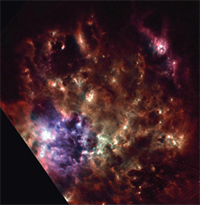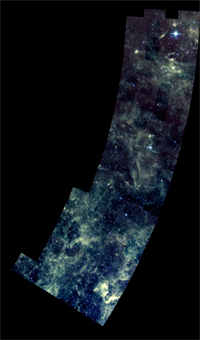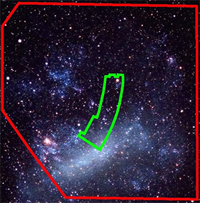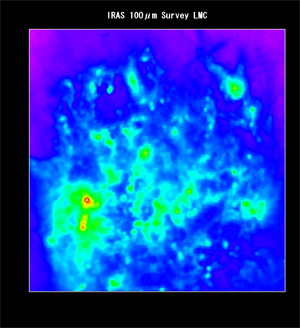TOP > Topics > 2006 > The quest to unravel the mysteries of galaxy formation: Infrared images of the Large Magellanic Cloud. --- AKARI moves towards completion of its first scan of the entire sky ---
![]()
The quest to unravel the mysteries of galaxy formation:
Infrared images of the Large Magellanic Cloud.
--- AKARI moves towards completion of its first scan of the entire sky ---
The Japan Aerospace Exploration Agency's (JAXA) infrared astronomical satellite AKARI [1] continues its mission to map the entire sky in infrared light. AKARI commenced the mission's All-Sky Survey observations in May, 2006 and will finish its first coverage of the entire sky in November. The estimated completeness of the coverage at the finish of the first coverage will be about 70 percent, which is what was expected, since some areas were known not to be presently observable due to disturbances by the Moon and other reasons.
During the survey observations, AKARI investigated one of the most important targets for studies of the formation of galaxies, the Large Magellanic Cloud [2], with more wavelength bands than has ever been made in the past, producing stunning images of our nearest neighbour in the Universe.
Infrared images of the Large Magellanic Cloud by AKARI and their implications
(1) Far-Infrared Image of the Large Magellanic Cloud
AKARI obtained a far-infrared image of the Large Magellanic Cloud showing very active star formation over the entire galaxy known as a "starburst". The image reveals the dust and gas (interstellar matter) distribution over the entire galaxy. Dust grains in these interstellar clouds are heated by the light from recently born stars, and subsequently re-radiate this energy as infrared light. The infrared emission indicates that a great number of stars are currently being formed in this galaxy. Such starburst phenomena are thought to take place in many galaxies during their growth and evolution. The nature of the Large Magellanic Cloud is further revealed by the contrasting structure of the interstellar matter forming the disk-like structure and the stars that are distributed in the "spindle" shape in the lower half of the image (see also appendix). The images from AKARI show that the two components are clearly displaced from one another. Astronomers believe that the observed active star formation and the displacement of these two components in the Large Magellanic Cloud were both triggered by the gravitational force from our own Milky Way Galaxy.
The AKARI All-Sky Survey will be far superior to the previous IRAS survey mission* especially in its ability to observe finer structure in the galaxy which will provide us with much more detailed information about the location and conditions of starburst. Using this data we will be able to unlock the secrets of the starburst process that plays such an important role in the formation of galaxies.
Figure 1: Far-Infrared image of the Large Magellanic Cloud by AKARI
(False-color composite from images at 60, 90 and 140 microns).
- AKARI image of the Large Magellanic Cloud. AKARI is continuing its observations to obtain this kind of data over the entire sky. This figure is a part of that data covering about 6x6 degrees (corresponding to a physical size of 17,000 x 17,000 light years at the distance of the galaxy)
- The bright region in the bottom-left is known as the “Tarantula Nebula”, and is a very productive factory of stars.
Figure 2: Near- and mid-infrared image of the Large Magellanic Cloud taken by AKARI (False color-composite from images at 3, 7 and 11 microns).
(2) Near- and Mid-Infrared Images of the Large Magellanic Cloud
In addition to the All-Sky Survey observations, AKARI also took further detailed images of a segment of the Large Magellanic Cloud at shorter near- and mid-infrared wavelengths (Figure 2). In contrast, this image shows many old stars in addition to the interstellar clouds. This image enables us to study the processes of how stars recycle and return their component gas back into the interstellar medium at the end of their lives. The unique capabilities of AKARI are again highlighted in the sheer number of stars detected in these images compared to the previous IRAS mission.
AKARI had some trouble at the beginning of the mission due to the fact that the two-dimensional Sun Sensor could not detect light from the Sun etc. Also the Star Trackers, one of the sensors for attitude control, have a problem on their cooling system. However, these problems have been successfully overcome, and now AKARI is in very good condition and continues to provide high-quality data such as the images shown here.
[1] The AKARI Project is carried out with the participation of mainly the following institutes; Nagoya University, The University of Tokyo, National Astronomical Observatory Japan, European Space Agency (ESA), Imperial College London, University of Sussex, The Open University (UK), University of Groningen / SRON (The Netherlands), Seoul National University (Korea). The far-infrared detectors were developed under collaboration with The National Institute of Information and Communications Technology.
[2] The Large Magellanic Cloud is a local, neighbouring galaxy just next to our Milky Way Galaxy to which our Solar System belongs. It contains about 10 billion stars (1/10 of our Galaxy) and is at a distance of 160,000 light years, extremely close by astronomical standards. The Large Magellanic Cloud is located in the constellation Dorados in the southern sky and thus unfortunately not visible from Japan. One can see this galaxy together with a smaller neighbouring galaxy, the Small Magellanic Cloud as two dim clouds in the sky. The name "Magellanic" is taken from the great 16th Century navigator Magellan who observed the clouds during his voyage around the world.
(*) IRAS was the first infrared astronomical satellite launched in 1983 by a joint team from the United States, The Netherlands, and the United Kingdom. It carried out the very first infrared All-Sky Survey, the results of which are still being used for astronomical purposes to this day. Similarly, AKARI promises a new valuable legacy for the decades to come.
Appendix 1: The Large Magellanic Cloud in visible light (courtesy of Mr. Motonori Kamiya) and areas of the AKARI images.
- The distribution of the stars can be clearly recognized from this visible image.
- The areas corresponding to AKARI's far-infrared (Figure 1) and near- & mid-infrared (Figure 2) images are indicated by the red and green lines respectively. The far-infrared image from AKARI reveals that the interstellar clouds extend to cover the entire galaxy in contrast to the stellar distribution that is concentrated in the lower part of the image.
Stars in a spindle shape is seen in bottom of the green frame.
Appendix 2: An image of the Large Magellanic Cloud taken by the preceding infrared astronomical satellite, IRAS (at the wavelength of 100 µm) (Infrared Processing and Analysis Center, Caltech/JPL)
|
November 1, 2006








